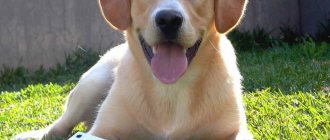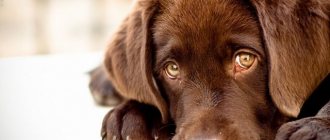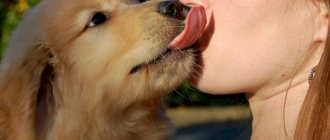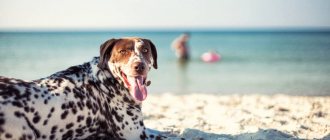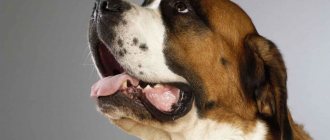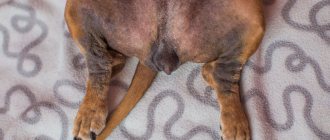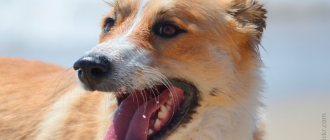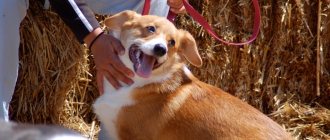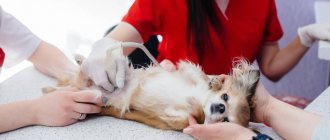In this article I will touch on such a common topic as dandruff in domestic dogs on the back and body. In addition to the reasons why this disease can be acquired, I will tell you what to do about it, help you choose the right treatment method, and also talk about preventing white plaque in puppies.
What is dandruff and what can it look like?
Dandruff is dead particles of the epidermis.
Normally, they are formed in small quantities due to natural aging and death of skin cells. If their formation accelerates and the number increases significantly (which can be seen with the naked eye), they talk about dandruff. The particles may resemble flour or cereal; they can be dry or “wet”, sticking together into lumps. The location of scales on a dog’s body is also different: they can cover the entire body, or be located in separate places - on the ears, tail, stomach, and so on. In addition, they differ in color: often there are not only white, but also black, pinkish, yellow and other particles of the epidermis. In any case, the appearance of dandruff on a pet gives it an unkempt appearance and requires an immediate search for the cause.
Dandruff in dogs in the photo
Why does dandruff appear in dogs?
There are many causes of dandruff in dogs. Among the most common are the following.
- Dietary disorders. Low quality food, high content of dyes and preservatives in pet food, predominance of one type of food in the diet over a long period of time, food poor in vitamins and minerals and many other mistakes are the most common factors leading to dandruff.
- Incorrect brushing. A dog brush should match the characteristics of the animal’s coat (length, thickness), sensitivity of the animal’s skin, and body size. Otherwise, damage to the epidermis and a response in the form of profuse detachment of scales are possible.
- Parasites. Both external parasites (mites, fleas) and internal ones can lead to excessive dandruff. In the latter case, the detachment of skin particles is provoked by an allergic reaction to intoxication.
- Dry air. This mainly applies to dogs living in an apartment and is related to heating. Excessively dry air and temperature changes (street - house) lead to drying of the animal's skin, which disrupts the processes of cellular renewal.
- Errors in care. This includes using human shampoos to wash the dog, bathing too often, overusing products intended for show (eg, polishes, gels) and other improper actions by the owner. As a result, the pet's skin becomes dry, flaky, and dandruff occurs.
- Shedding. The formation of dandruff on the back often accompanies a dog's shedding. When this period ends, the skin regeneration process is also restored.
- Fungal infections. A fungus can lead to excessive detachment of skin scales. More often, fungal diseases affect dogs with a folded body surface.
- Stress. Nervous stress disrupts metabolic processes throughout the dog’s body, including skin renewal processes. At the same time, a stressful situation can be provoked by any phenomenon: the departure of the owner, a change of place of residence, rearrangement in the house, fear, and so on.
- Age characteristics. In puppies, dandruff may be due to the final formation of the epidermis. During puppyhood, the formation of nerve endings and reflexes and the formation of activity of the sebaceous glands still continues (and ends).
- Allergy. It can occur for anything: food, substances, hygiene products, other pets, and so on.
- Internal illnesses. Metabolic disorders caused by hormonal imbalance, malignant tumors, bacterial and viral diseases are often the cause of dandruff in dogs.
Attention: due to the large number of factors leading to the formation of dandruff, diseases and parasites must first be excluded. Before taking independent action, you need to go to the clinic and have your dog examined.
Dandruff and other symptoms
Dandruff in dogs can occur on its own, or it can be accompanied by other symptoms that help suggest the cause of the problem. For example, a floury appearance of dandruff with a dull coat often indicates dry skin, lack of hydration and nutrition.
Clumped particles of the epidermis, yellowish or gray in color, “hint” at a skin disease, pathology of the sebaceous glands or hormonal imbalance. Additional symptoms include: an unpleasant odor, a “dirty”, greasy appearance of the coat, the presence of bald spots, and itchy areas. The dog becomes restless and often itches, which leads to scratching and secondary infection.
Excessive dandruff, accompanied by baldness, is evidence of an infectious skin disease (fungus), a lack of vitamin C and Zn in the body, disturbances in the functioning of the sebaceous glands, and endocrine pathologies. For example, hair loss and excessive peeling of the epidermis near the tail may be a sign of blockage of the anal glands.
Sometimes the owner may notice black “dandruff”. In fact, these are droplets of blood or clogged sebaceous glands on the dog’s body, indicating an incorrect combing technique or disturbances in the activity of the endocrine and sebaceous glands.
If yellowish dandruff appears, seborrhea can be suspected. The pinkish color of the scales may indicate the development of inflammation of the skin and the peeling of pieces of it.
Methods for diagnosing dandruff in dogs
First of all, the specialist will find out why the dog has dandruff. To do this, the doctor will need the following information:
- associated symptoms;
- presence/absence of chronic or recent acute diseases;
- localization of dandruff and its intensity;
- general condition of the dog (apathy or activity, thirst, excess weight);
- characteristics of the animal’s diet and living conditions.
The required examination will depend on the suspected diagnosis. For example, if a specialist suspects a dysfunction of the thyroid gland, he will prescribe a blood test for hormones, and in the case of skin infections, a scraping of the epidermis.
Kinds
Based on consistency, there are two types of seborrhea - dry and oily. Most dogs develop a combination of both. The color of the exfoliated plates is usually grayish-white.
The dog has dandruff
However, when examining the skin, black dandruff is sometimes discovered. This is flea excrement, which consists of partially digested red blood cells.
Flea excrement
Seborrhea is classified according to its origin as primary (idiopathic) or congenital seborrhea. Dandruff occurs in adult dogs and progresses. The following breeds are predisposed:
- spaniels;
- Dobermans;
- German Shepherds;
- Shar-Pei;
- dachshunds;
- Labradors.
Secondary dandruff occurs as a symptom of an underlying disease.
Treatment of dandruff in dogs
Treatment of dandruff in four-legged friends is symptomatic and is necessarily accompanied by the elimination of the factor that caused it. All manipulations are aimed at alleviating the dog’s condition: eliminating itching, reducing the rate of formation and the number of scales, normalizing metabolic processes in the skin and body, increasing immunity, restoring the pH of the skin, and so on. The key to success is an integrated approach - in addition to treating the underlying disease (if it exists), medications are prescribed that eliminate the symptoms of dandruff, medicated shampoos, and folk remedies are used.
Shampoos
To eliminate itching and cleanse the dog’s skin of dandruff, veterinarians recommend using shampoos containing salicylic acid, tar, and sulfur. To get rid of parasites, products containing the appropriate components are used. The following shampoos are the most popular.
- Lactaderm. Has antiseptic and exfoliating properties. Gently moisturizes the skin and helps restore the upper layer of the epidermis and normal microflora. Has a deodorizing effect.
- Tropiclean. Eliminates itching and has a calming effect on irritated skin. Effective against parasitic insect bites, leading to their death. Softens the stratum corneum of the epidermis, restores moisture levels in the skin and hair.
- Doctor. Effectively removes dead skin particles and sebaceous gland secretions from the dog's body. Eliminates itching, reduces the volume of sebaceous secretion, has an anti-inflammatory and antiseborrheic effect. Doctor shampoo is successfully used for fungal and bacterial skin infections, and also increases the effectiveness of other external antimicrobial drugs.
Wash me completely
Drugs
Simultaneously with shampoos, the use of external and/or internal medicinal preparations is indicated. For example, if your dog is very itchy, your doctor may prescribe steroids to relieve inflammation. When identifying external parasites, it is possible to use such products as Stronghold (drops), Frontline (spray). To restore hair in dogs, the biological preparation Nucleopeptide is recommended, as well as the French-made product Essential. Vitamins Nutricoat and Power balance, Lozeval (externally and internally) will help support the immune system and normalize the condition of the skin and coat from the inside.
Additionally, the intake of vitamins A, C, and group B is indicated. Brewer's yeast, wheat germ, flaxseed, seaweed and other foods rich in macro- and microelements are added to the feed.
Folk remedies
Traditional methods are also excellent for eliminating the symptoms of dandruff in dogs. Oils, herbal decoctions and infusions are used externally in the form of rubdowns, compresses, lotions; Small dogs can be rinsed with decoctions after washing. Chamomile, linden, nettle, and burdock relieve inflammation and irritation well. Oils you can use are burdock, sea buckthorn, and olive.
Medications
Since primary seborrhea cannot be completely cured, all medical measures are aimed at removing the symptoms. This is the use of shampoos that eliminate itching and flaking. Such products must contain: salicylic acid, peroxide, tar extract, sulfur.
A specialist can recommend the following effective means:
- Stop 3 beats Perfectly eliminates dandruff and itching that torments the animal. The spray soothes the skin well. A product that is used to eliminate diseases associated with skin conditions;
- Frontline. Gets rid of parasites, thus eliminating dandruff and redness. This remedy is often used for preventive purposes;
- Shampoo Doctor. After the first use, the shampoo can completely eliminate dandruff. The shampoo contains tar and may also be suitable for dogs with chronic skin diseases. There are many options for different breeds and coat types.
How to help your dog with dandruff
Regardless of the cause of dandruff in dogs and what treatment the doctor prescribed, the owner must take some actions to alleviate the condition of his four-legged friend.
- Make changes to your diet. If the food was monotonous, introduce additional products (change food). Enrich your diet with vitamins, especially A and E, and omega acids. Ensure adequate supply of nutrients. Make sure there are no artificial additives in your food.
- Scratch your pet regularly. With a daily procedure, not only the exfoliation and removal of dead scales occurs, but also the improvement of blood flow in the epidermis, the normalization of metabolism and the functioning of the sebaceous glands.
- Increase air humidity in the house.
- Use only the shampoo that has been approved by your doctor. Do not use a hairdryer for drying under any circumstances - the pet should dry naturally.
- If the diagnosis is related to the presence of external parasites, treat not only the dog, but also the bedding, as well as the apartment (floor, furniture, bedspreads).
Possible consequences
If dandruff is a symptom of a systemic disease, without adequate treatment it will progress. For example, with diseases of the gastrointestinal tract, a dog loses its appetite and loses weight due to diarrhea or vomiting. This can lead to the death of your pet due to dehydration.
If the causes of dandruff are not related to diseases of the internal organs, then in the absence of treatment, the sebaceous ducts become clogged and acne occurs. An increase in sebum synthesis provokes the addition of a fungal or bacterial infection. As a result, the dog's hair comes out, severe itching occurs, and ulcers appear. Scratching the affected areas of the skin spreads the infection.
Prevention of dandruff in dogs
What can you do to avoid dandruff in dogs? The main preventive measures are the following:
- ensure a balance of vitamins, minerals, and nutrients in your pet’s food;
- eliminate stress;
- do not bathe the dog more than once a quarter (or depending on the soiling);
- use special bathing products;
- comb your dog correctly and use an appropriate comb;
- Monitor the condition of your pet’s skin, regularly check for parasites, skin damage, and allergic manifestations.
Dandruff in dogs is easy to treat if it is detected early and the cause is identified. In advanced cases, treatment may take several months and require significant material costs. In addition, it will be much more difficult to detect the factor that provokes the disorder, so the key to the health of the animal and the peace of mind of the owner is an attentive attitude towards the pet.
Risk group
At risk are dog breeds with a predisposition to seborrhea and sebadenitis:
- Poodle.
- Akita Inu.
- Samoyed dog.
- Hovawart.
- American Cocker Spaniel.
- English Springer Spaniel.
- West Highland White Terrier.
- Basset Hound.
And also pets, regardless of breed, if:
- They are not properly cared for (rare bathing, not combing their fur).
- Unbalanced diet.
- If you use cheap, untested shampoos or products not intended for dogs to bathe your pet.
- There are no treatments for external and internal parasites.



